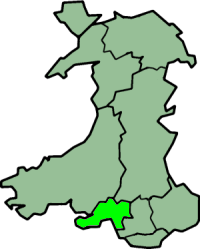West Glamorgan
| West Glamorgan Welsh: Gorllewin Morgannwg |
|
|---|---|
 West Glamorgan shown within Wales as a preserved county |
|
| Area | |
| • 2003 | 820 km² Ranked 6th |
| Population | |
| • 2007 | 365,500 (est; 2003 borders) Ranked 6th |
| History | |
| • Created | 1974 |
| • Abolished | 1996 |
| • Succeeded by |
Swansea Neath Port Talbot Preserved county of West Glamorgan |
| Status | Non-metropolitan county (1974–1996) Preserved county (1996–) |
| Government | West Glamorgan County Council |
 Coat of arms of West Glamorgan County Council |
|
| Subdivisions | |
| • Type | Non-metropolitan districts |
| • Units | 1. Swansea 2. Lliw Valley 3. Neath 4. Port Talbot |
Coordinates: 51°49′19″N 3°49′59″W / 51.822°N 3.833°W
West Glamorgan (Welsh: Gorllewin Morgannwg) is a preserved county and former administrative county of Wales, one of the divisions of the ancient county of Glamorgan.
West Glamorgan was created on 1 April 1974, by the Local Government Act 1972 from the county borough of Swansea, the municipal boroughs of Neath and Port Talbot, the urban districts of Glyncorrwg and Llwchwr, Gower Rural District, Pontardawe Rural District, and all of Neath Rural District except the parish of Rhigos. From 1982, the main council offices were located in County Hall, Swansea.
West Glamorgan had four districts, as follows:
Following the Local Government (Wales) Act 1994, West Glamorgan and its component districts were abolished on 1 April 1996, the area being divided into the two unitary authorities of Swansea and Neath and Port Talbot. Lliw Valley was partitioned between the two authorities. A West Glamorgan preserved county was created for the limited functions of Lieutenancy and High Shrievalty.
...
Wikipedia
